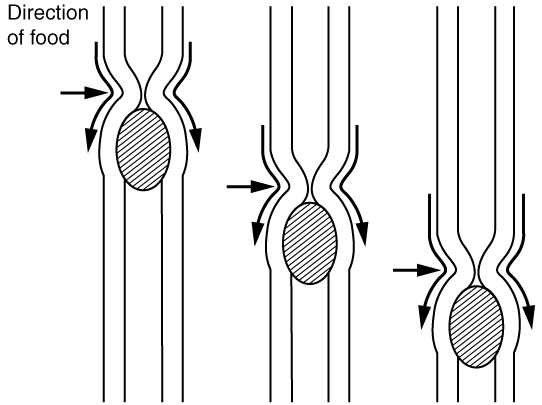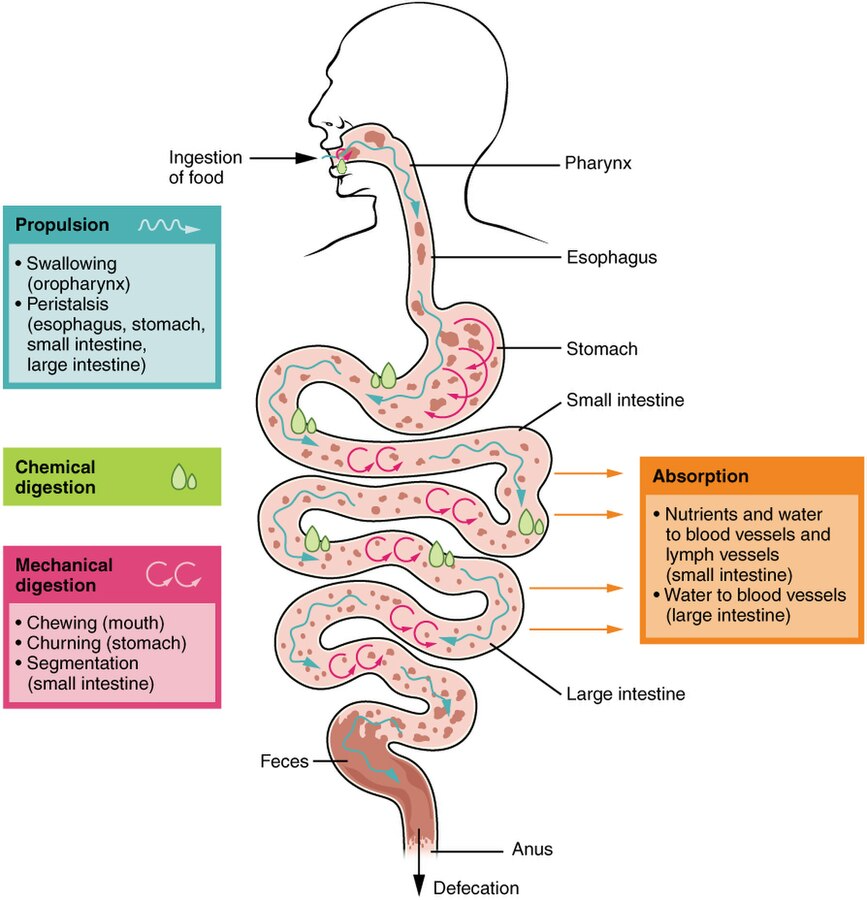14.2 Functions of the Digestive System
Functions of the Digestive System[1]
The functions of the digestive system are to bring food into the body (ingestion), break down the foods you eat (digestion), absorb those nutrients (absorption), and eliminate wastes from the body (defecation). These functions are further described in the following subsections.
Ingestion
Ingestion refers to eating or bringing food into the GI tract through the mouth. In the mouth, food is chewed and mixed with saliva that contains enzymes that begin breaking down carbohydrates in the food. Chewing increases the surface area of the food and allows an appropriately sized bolus (mass of chewed food) to be produced.
Food leaves the mouth when the muscles of the tongue and pharynx (throat) move it into the esophagus. This act of swallowing is one of the few voluntary actions in the digestive process and serves as an example of propulsion, the movement of food through the digestive tract. The next time voluntary muscles are used is during defecation.
Peristalsis consists of involuntary, alternating wave-like contraction and relaxation of smooth muscles. In the GI system, peristalsis moves food along the length of the digestive tract. See Figure 14.2[2] for an illustration of peristalsis.

View a supplementary YouTube video[3] about peristalsis: Peristalsis and Segmentation.
Digestion
Digestion includes both mechanical and chemical processes. Mechanical digestion is a physical process that does not change the chemical nature of the food but makes it smaller to increase surface area and mobility. It includes mastication (chewing), as well as tongue movements that help break food into smaller bits and mix food with saliva. The mechanical churning of food in the stomach serves to further break it apart and expose more of its surface area to digestive juices, creating an acidic “soup” called chyme. Segmentation, which occurs mainly in the small intestine, consists of localized contractions of smooth muscle wall. These contractions isolate small sections of the intestine, moving their contents back and forth while continuously subdividing, breaking up, and mixing the contents. By moving food back and forth in the intestinal lumen, segmentation mixes food with digestive juices and facilitates absorption.
Chemical digestion utilizes enzymes to break down food. It begins in the mouth, continues in the stomach, and ends in the small intestine. Digestive secretions break down complex food molecules into their chemical building blocks (for example, proteins are broken down into amino acids). These digestive secretions vary in composition, but typically contain water, enzymes, acids, and salts.
Absorption
For nutrients to be used by the body, they must enter the bloodstream and travel to our cells. This occurs through the process of absorption, which takes place primarily in the small intestine. There, most nutrients are absorbed directly into the bloodstream through the epithelial cells that make up the mucosa. Lipids, however, are absorbed into lacteals and are transported via the lymphatic vessels to the bloodstream. The details of these processes are discussed later in this chapter.
Defecation
Defecation is the final step in digestion as undigested materials are removed from the body as feces. See Figure 14.3[4] for an illustration of the functions of the digestive system.

- Betts, J. G., Young, K. A., Wise, J. A., Johnson, E., Poe, B., Kruse, D. H., Korol, O., Johnson, J. E., Womble, M., & DeSaix, P. (2022). Anatomy and physiology 2e. OpenStax. https://openstax.org/books/anatomy-and-physiology-2e/pages/1-introduction ↵
- “2404_PeristalsisN” by OpenStax College is licensed under CC BY 3.0 ↵
- Vutey VENN. (2014, November 3). Peristalsis and segmentation [Video]. YouTube. All rights reserved. https://www.youtube.com/watch?v=1yMTmoZhemQ ↵
- “2405_Digestive_Process” by OpenStax College is licensed under CC BY 3.0 ↵
Eating or bringing food into the GI tract through the mouth.
Mass of chewed food.
The movement of food through the digestive tract.
Involuntary, alternating wave-like contraction and relaxation of smooth muscles.
A physical process that does not change the chemical nature of the food but makes it smaller to increase surface area and mobility.
Anatomical term for chewing.
Acidic “soup”.
Occurs mainly in the small intestine, consists of localized contractions of smooth muscle wall.
The process by which enzymes and acids break down food molecules into their chemical building blocks.
The innermost layer of the gastrointestinal tract that secretes mucus and absorbs nutrients.
Final step in digestion as undigested materials are removed from the body as feces.

